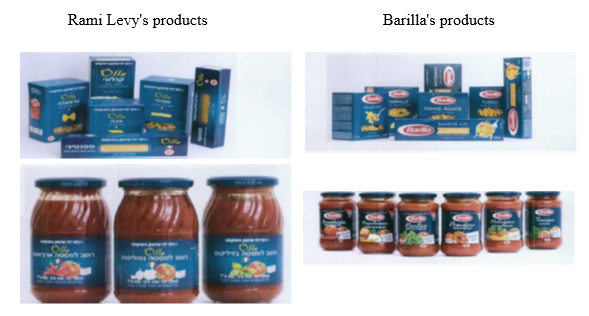[Leave to Appeal 1521/18 Rami Levy "Hashikma" Marketing 2006 Limited v. Barilla G. e R. Fratlli S.p.A.—ruling dated April 22, 2018]
1. In a recent ruling rendered by the Israeli Supreme Court (the "Court"), Justice Solberg tackled a few of the core questions regarding the civil wrong of passing off – how should the line between inspiration and imitation be drawn? To what extent should functional elements be taken into account when assessing competing products? Figuratively speaking – how far must one venture away from "the box" in order to be able to think outside of it?
2. Unfolding of events: the plaintiff, Barilla G. e R. Fratlli S.p.A. ("Barilla"), one of the world's leading manufacturers and marketers in the pasta industry, filed a lawsuit with the Tel Aviv District Court against the defendant, Rami Levy "Hashikma" Marketing 2006 Limited ("Rami Levy"), a local retailer known for its discount pricing in supermarkets. Barilla sought to obtain an interim injunction for the removal of all Rami Levy's "Olla" branded pasta and sauce products from its shelves, claiming that the designs of Rami Levy's packages/jars in respect of its aforesaid branded products significantly resemble Barilla’s packages/jars of its well-known pasta products and sauces and, thus, are likely to mislead customers. Acknowledging the goodwill acquired by Barilla in its products and their packaging, the District Court ruled that Rami Levy’s packaging of its pasta branded products are likely to mislead customers, while its jars of branded sauces are unlikely to do so.
3. Below are photographs of both parties’ branded products subject-matter of the proceedings:

4. Rami Levy filed an appeal with the Court seeking that the injunction, as granted by the District Court in respect of the packaging of its pasta branded products, be revoked, while Barilla submitted an appeal seeking that the said injunction need be broadened further to encompass also Rami Levy’s jars of branded sauces.
5. The Court examined the elements of passing off in the given circumstances, namely: the existence of goodwill acquired by Barilla in its products and packaging and the likelihood of confusion, taking into account that the required standard of proof (owed by Barilla) is prima facie evidence. The Court held that Barilla has prima facie established its goodwill by its evidence concerning the extent of advertisement and volume of sale of its products in Israel. With respect to both the pasta packages and the jars of sauces, the Court held that the overall appearance of Rami Levy's packaging leaves no doubt as to the scope of reliance on the "gestalt" (concept of design) of Barilla’s products. The Court also stated that the imitation of the packaging design itself constitutes prima facie evidence of the goodwill acquired by Barilla in its products and packaging. In view of the above, the Court found that Barilla had met the burden of proof regarding the goodwill acquired by it in the overall appearance of its products.
6. As for the likelihood of confusion, the Court implemented the "triple test", noting that one need not prove an intention to mislead or an actual misleading act - only the likelihood of de facto confusion. We will get back to this important remark later on but first we shall examine the Court's ternary reasoning
- The first test: "visual and phonetic" is considered the primary test among the three. As mentioned above, it was determined, with respect to both the pasta packages and the sauces jars, that the visual resemblance meets the relevant standard (i.e. prima facie evidence). This conclusion was based first and foremost on the prevailing approach that the Court should focus on the general impression of the examined products and refrain from getting caught up in details. The Court acknowledged that there were some differences between the two packages that could assist in distinguishing between the brands, but only when carefully inspecting the packages. Thus, it was held that the efficacy of these elements in avoiding confusion among the reasonable consumer is questionable.
- The second test: "type of goods and customer" - the Court held that the type of goods and customer base are identical. In addition, bearing in mind the nature and cost of the goods (pasta and sauce), the amount of time and attention spent on choosing such goods is relatively limited and so is the customers' attention, which may also be easily distracted by the busy environment. The Court also mentioned that, in this case, price would not be considered a distinguishing factor.
- The third test: "additional circumstances" – the lack of evidence pertaining to the design process and the absence of testimony being given by Rami Levy's professional designer, aggravated the Court's existing doubts concerning the "mens rea" of Rami Levy when designing the packages/jars.
7. The Court thus concluded that Barilla had satisfied the burden of proof required for establishing passing off as required in proceedings of this nature. Nonetheless, the Court held that Barilla had failed to satisfy the burden of proof for demonstrating that the blue box, as such, has acquired distinctive character in Israel, and thus enable it to enjoy the exclusivity of having a monopoly over its blue box design.
8. Upon analyzing the balance of convenience, the Court compared the damage the parties might suffer and concluded that there is a tangible fear of the alleged likelihood of confusion causing significant harm to Barilla, as opposed to the merely potential damage to be suffered by Rami Levy, which could easily be quantified for compensation purposes, if necessary. The Court further remarked that Rami Levy can easily "think outside of the box" and market its products in packages bearing different features and designs. The Court admitted that it was unusual to grant an interim injunction that equals the final injunction sought, however, under the given circumstances, and due to the high chances of Barilla succeeding in its claim – the balance of convenience tilts in Barilla's favor. Consequently, Rami Levy was instructed to remove all its “Olla” branded pasta and sauce products from its shelves and bear Barilla's expenses in the proceedings.
9. The Barilla v. Rami Levy case provides a detailed analysis of the products’ design elements and compares them thoroughly in order to determine whether a likelihood of confusion existed. A question remaining open concerns the proper method for distinguishing between an imitation and inspiration and what role does the mens rea of the defendant play in making such distinction. Is it apt that lack of evidence pertaining to the design process be held against the defendant (and, thus, alleviate the required burden of proof owed by the plaintiff)?
We thank Ms. Yarden Enacab for her valuable assistance in preparing this report.





